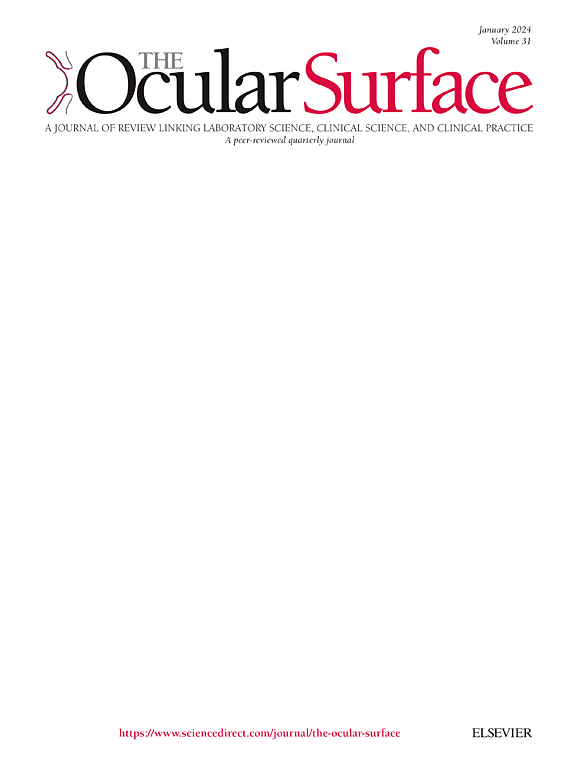眼光敏度分析仪测量的视光敏度升高的不适与慢性眼痛有关
IF 5.6
1区 医学
Q1 OPHTHALMOLOGY
引用次数: 0
摘要
量化慢性眼痛(COP)患者的视觉光敏性不适阈值(VPDT),并与无COP的对照组进行比较,探讨VPDT、人口统计学、临床因素和眼部指标之间的关系。本文章由计算机程序翻译,如有差异,请以英文原文为准。
Heightened visual light sensitivity discomfort measured by the ocular photosensitivity analyzer is associated with chronic ocular pain
Purpose
To quantify visual photosensitivity discomfort thresholds (VPDT) in individuals with chronic ocular pain (COP) compared to controls without COP and explore relationships between VPDT, demographics, clinical factors, and ocular metrics.
Methods
Prospective case-control study of 75 participants: 36 with COP (age 46.5 ± 15.6 years; 56 % female) and 39 controls (39.2 ± 15.6 years; 56 % female). COP was defined by self-reported ocular pain intensity ≥15 on a numerical rating scale (range, 0–100) for ≥3 months. COP cases were subclassified into inflammatory (Sjögren's disease) and neuropathic ocular pain subgroups. VPDT was measured using the Ocular Photosensitivity Analyzer (OPA), and ocular symptoms were assessed using the Visual Light Sensitivity Questionnaire (VLSQ-8; 8–40) and Ocular Surface Disease Index (OSDI; 0–100), with OSDI Question 1 addressing light sensitivity (OSDI-Q1; 0–4).
Results
COP patients exhibited lower VPDT than controls (log lux, 1.60 ± 1.17 vs. 2.42 ± 1.05; P = 0.006), indicating greater photosensitivity discomfort. No differences in VPDT were seen across COP subtypes. COP patients also reported greater symptom severity than controls, with higher VLSQ-8 (21.92 ± 1.41 vs. 9.03 ± 0.53), OSDI (50.84 ± 3.88 vs. 2.82 ± 0.85), and OSDI-Q1 (2.00 ± 0.24 vs. 0.14 ± 0.06) scores (all P < 0.001). VPDT negatively correlated with VLSQ-8 (ρ = −0.75) and OSDI-Q1 (ρ = −0.62), demonstrating alignment between subjective light sensitivity symptoms and OPA-measured photosensitivity discomfort. Multivariable regression identified fibromyalgia as the strongest predictor of VPDT (19.6 % variance explained), with chronic fatigue improving the model (26.5 %).
Conclusion
COP subjects display greater photosensitivity-related discomfort than controls, highlighting the OPA's potential as a psychophysical tool for quantifying photoallodynia. Further research is needed to assess its diagnostic utility across COP subtypes.
求助全文
通过发布文献求助,成功后即可免费获取论文全文。
去求助
来源期刊

Ocular Surface
医学-眼科学
CiteScore
11.60
自引率
14.10%
发文量
97
审稿时长
39 days
期刊介绍:
The Ocular Surface, a quarterly, a peer-reviewed journal, is an authoritative resource that integrates and interprets major findings in diverse fields related to the ocular surface, including ophthalmology, optometry, genetics, molecular biology, pharmacology, immunology, infectious disease, and epidemiology. Its critical review articles cover the most current knowledge on medical and surgical management of ocular surface pathology, new understandings of ocular surface physiology, the meaning of recent discoveries on how the ocular surface responds to injury and disease, and updates on drug and device development. The journal also publishes select original research reports and articles describing cutting-edge techniques and technology in the field.
Benefits to authors
We also provide many author benefits, such as free PDFs, a liberal copyright policy, special discounts on Elsevier publications and much more. Please click here for more information on our author services.
Please see our Guide for Authors for information on article submission. If you require any further information or help, please visit our Support Center
 求助内容:
求助内容: 应助结果提醒方式:
应助结果提醒方式:


